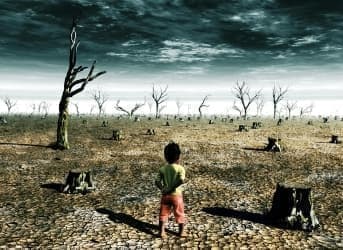Half a decade of drought has forced the migration of 1.5 million rural residences to Syria’s urban centers, as the regime has paid little attention to water and agricultural issues, and this grossly overlooked climate situation has and will continue to help shape the outcome of the conflict and the prospects for future stability.
According to a recent study released by the Bulletin of the Atomic Scientists, the “unparalleled” drought in Syria from 2006 to 2010 led to the mass migration of 1.5 million people to urban centers, while the regime of Bashar al-Assad systematically ignored urgent issues of water access and sustainable agriculture, leading to the complete destruction of a large number of farming communities and placing immense stress on urban centers.
While the study does not assume that the drought was a leading cause of the conflict in Syria, it does insist that “drought-induced migration from farm to city clearly contributed to the uprising and serves as a warning of the potential impact of climate change on political stability.” Overlooked, the study says, is the fact that climate has played a “subtle, yet powerful” role in dictating the conflict, and is partly the reason that many predicted that after Egypt, an uprising in Syria would not unfold. Those predictions were based on the regime’s strength and fear of the regime, and ignored climate-induced demographic changes.
Dr. Dominic Moran, the Arab World Project Coordinator for Greenpeace, agrees, having spent much of his career following the influence of climate change on conflict dynamics.
"While it is difficult to isolate environmental crises as contributing factors in conflict development and exacerbation, the mass mobility of climate change induced drought in Syria will be having an important impact on the burgeoning humanitarian crisis,” Dr. Moran told Oilprice.com.
"Forced or induced migration from rural to urban centers, in a situation of economic malaise in the cities, breaks the traditional familial and community bonds of social support and welfare that provide a fallback in conflict situations while increasing reliance on alternative networks of support. The latter are predominantly Islamic in orientation given the progressive retreat of the state from welfare provision in many Arab states. How this is impacting the revival of the Brotherhood and development of Salafi movements within the opposition and associated fighting groups in Syria will likely only emerge in the event of their victory in the civil war,” he said.
Climate’s role in conflict is generally overlooked, or at best only lightly considered. The same is true for Yemen, where analysis and policy focus largely on politics and geopolitics. As Oilprice.com noted in an earlier article, water continues to play a key role in shaping the conflict in Yemen. Notably, Yemen’s southern highland areas, under al-Qaeda control, has long been plagued by inter-communal conflicts for control of wells and water sources. When al-Qaeda steps in it brings with it a modicum of authority over water sources and gains local support because of this. This in turn substantially shapes the conflict dynamics.
In Syria, as Dr. Moran points out, “it is notable that the drought has been worst in north-east areas quickly slipping from state control and in the south where the rebellion started.”
While Syria is no stranger to drought, the most recent drought lasted for four years—too long for agricultural communities to bounce back and salvage something from the damage. It was, according to the Atomic Scientists’ study, a “true anomaly”, the magnitude of which cannot be explained by simple variables in nature.
The implications of this drought and the regime’s gross mismanagement of agriculture are that Syria’s breadbasket has been depleted and the urban centers cannot sustain the population influx, while the conflict is fed by disillusioned masses of out-of-situation rural farmers.
ADVERTISEMENT
By. Charles Kennedy for Oilprice.com


















